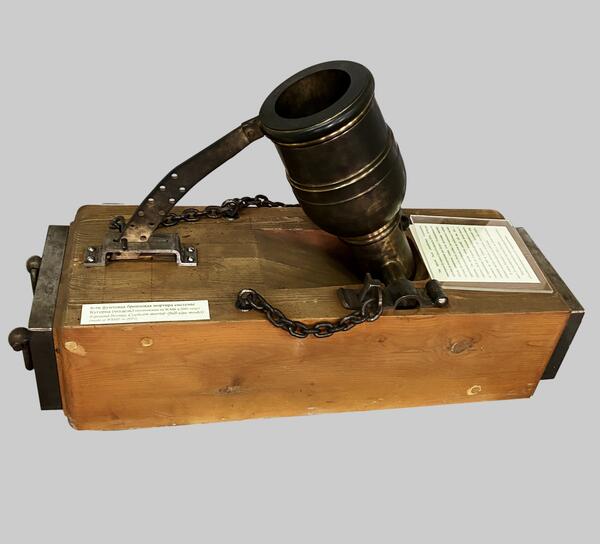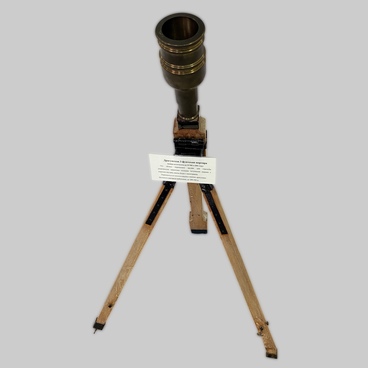Exact copies of mortars were manufactured at the ZSMK especially for the museum. Significant preliminary work preceded the manufacture: study of the archives and collections of the Museum of Military History of Artillery, Engineering and Signal Troops, measurements were taken, authentic drawings were copied. Now, the collection of Kuznetsk Fortress museum contains 22 accurate copies of the guns and mortars whose prototypes were in operational service in the fortress.
According to the standard munitions list, apart from the guns, there were Coehorn mortars in the fortress. Baron Menno van Coehorn, or Minno de Cohorn, is a Dutch military engineer who did much for the development of fortification and invented an option of a star fort. His work mainly coincided in time with the wars of France with the Netherlands that lasted between 1672 and 1678, 1688 and 1697, and 1702 and 1713 years.
Coehorn who supported active defense in fortress protection was the first to suggest using in the sieges many small size mortars throwing grenades. Those small mortars got their name in his honor, In 1703, 500 such mortars were used against Bonn, and within three days the fortress capitulated.
Coehorn’s ideas had a significant impact on the development of fortification, especially in Russia. Coehorn’s defensive fortifications- — ‘vErki”— were located the way that allowed an intense cross fire on the locality. 6-pounder Coehorn mortars were easy to carry and gave an opportunity of more efficient attacks against the enemy troops.
Ordinary stub-barrelled mortars for angle fire shot heavy bombs of 1 to 6 “poods”(weight measure -16.38 kg). Those were large balls of cast iron filled with explosives and case shot. Such bombs exploded in the air covering a large area near the fortress walls. But heavy mortars were difficult to manoeuvre. They could only be turned a little with the help of levers. Coehorn”s mortars had better mobility – they allowed concentrating fire on those defense areas where it was necessary.
In Russia those mortars were accepted for service during the reign of Peter I. The calibre of Coehorn”s mortars was 104 mm, and their weight with the gun carriage achieved 38-41 kg. They threw grenades weighing ca.3 kg. Each grenade was charged with 130 g of artillery powder, and maximal shooting distance did not exceed 600 m. Coehorn”s mortars were in service with the Russian Army until the World War I.
According to the standard munitions list, apart from the guns, there were Coehorn mortars in the fortress. Baron Menno van Coehorn, or Minno de Cohorn, is a Dutch military engineer who did much for the development of fortification and invented an option of a star fort. His work mainly coincided in time with the wars of France with the Netherlands that lasted between 1672 and 1678, 1688 and 1697, and 1702 and 1713 years.
Coehorn who supported active defense in fortress protection was the first to suggest using in the sieges many small size mortars throwing grenades. Those small mortars got their name in his honor, In 1703, 500 such mortars were used against Bonn, and within three days the fortress capitulated.
Coehorn’s ideas had a significant impact on the development of fortification, especially in Russia. Coehorn’s defensive fortifications- — ‘vErki”— were located the way that allowed an intense cross fire on the locality. 6-pounder Coehorn mortars were easy to carry and gave an opportunity of more efficient attacks against the enemy troops.
Ordinary stub-barrelled mortars for angle fire shot heavy bombs of 1 to 6 “poods”(weight measure -16.38 kg). Those were large balls of cast iron filled with explosives and case shot. Such bombs exploded in the air covering a large area near the fortress walls. But heavy mortars were difficult to manoeuvre. They could only be turned a little with the help of levers. Coehorn”s mortars had better mobility – they allowed concentrating fire on those defense areas where it was necessary.
In Russia those mortars were accepted for service during the reign of Peter I. The calibre of Coehorn”s mortars was 104 mm, and their weight with the gun carriage achieved 38-41 kg. They threw grenades weighing ca.3 kg. Each grenade was charged with 130 g of artillery powder, and maximal shooting distance did not exceed 600 m. Coehorn”s mortars were in service with the Russian Army until the World War I.



